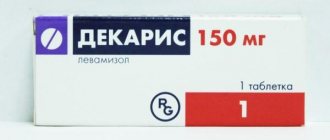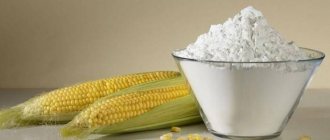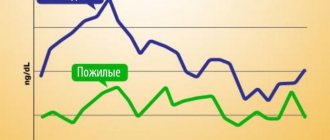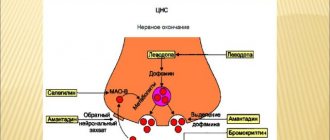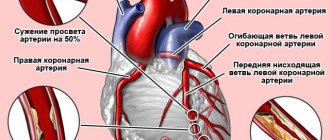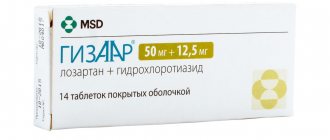Release form and composition
Leukeran is produced in the form of tablets: round, biconvex, brown, engraved on one side - “GX EG3”, on the other - “L” (25 pieces in dark glass bottles, 1 bottle in a cardboard box).
Composition of the drug (in 1 tablet):
- Active ingredient: chlorambucil – 2 mg;
- Auxiliary components: microcrystalline cellulose, stearic acid, colloidal anhydrous silicon, anhydrous lactose;
- Shell composition: Opadry brown YS-1-16655A (macrogol, titanium dioxide, hypromellose, red iron oxide and yellow iron oxide dyes).
What can be replaced
We continue to consider the instructions for use for Leukeran. Analogs of this drug should have the same therapeutic effect. If the drug contains the same substance, it is called a synonym. For Leukeran tablets, this is the drug Chlorbutyl, also available in tablet form.
Medicines that are analogues of Leukeran may have a slightly different composition, but will have a similar effect. Such drugs include “Alkeran” based on melphalan, “Endoxan” and “Cyclophosphamide”, which contain cyclophosphamide, “Ribomustin”, the active substance in which is bendamustine. The group of alkylating drugs also includes other drugs that have a cytotoxic effect and are used in the treatment of oncological diseases. Which drug should be used in each specific case is decided only by the attending physician, taking into account the individual characteristics of the patient’s body and the course of the disease.
Contraindications
Strict contraindications to the use of the drug are:
- Pregnancy;
- Lactation;
- Hypersensitivity to its components.
With caution, after a careful assessment of the benefit-risk ratio, Leukeran is prescribed in the following cases:
- Chickenpox, including recent chicken pox;
- Infiltration of bone marrow by tumor cells;
- Suppression of bone marrow function (thrombocytopenia, severe leukopenia and anemia);
- Acute infectious diseases of viral, bacterial and fungal nature;
- Shingles;
- Epilepsy, incl. in the anamnesis;
- Urate nephrourolithiasis;
- Severe liver and kidney diseases;
- History of gout;
- History of head injuries.
Possible consequences of therapy
It is required to strictly follow the doses prescribed in the instructions for use for Leukeran. They are defined for each disease for which this remedy is prescribed. We should not forget about the possible side effects of treatment with tablets containing chlorambucil. The negative effects of this medicine may include the following:
- Azoospermia.
- Amenorrhea.
- Gastrointestinal disorders.
- Jaundice.
- Leukemia in acute form, appearing after a course of drug therapy.
- Feverish condition.
- Myelosuppression.
- Liver dysfunction.
- Peripheral neuropathy.
- Toxic epidermal necrolysis.
- Pneumonia.
- Convulsive seizures, to which children with nephrotoxic syndrome are especially prone.
- Stevens-Johnson syndrome.
- Skin rash.
- Aseptic cystitis.
- Pulmonary fibrosis.
Let us note once again that when undergoing treatment with this drug, the patient must strictly adhere to the recommended dosage. If for any reason the drug was taken more than necessary, the following health disorders occur: ataxia, increased excitability, reversible pancytopenia, epileptic seizures. There is no specialized antidote for chlorambucil, so assistance in case of overdose is limited to symptomatic therapy after removing the drug by gastric lavage. During this period, blood tests should be carried out regularly and the body’s functionality should be maintained with the help of medical procedures and medications.
Directions for use and dosage
Leukeran is usually taken as part of combination therapy, so when selecting doses, you should consult special literature.
The tablets should be taken orally, swallowing whole. Don't share!
As a single drug for Hodgkin's disease, Leukeran is usually prescribed at a dose of 0.2 mg/kg/day. The course of treatment is 4-8 weeks.
As monotherapy for non-Hodgkin's lymphomas, the drug is usually prescribed at a dose of 0.1-0.2 mg/kg/day. The duration of the main treatment is 4-8 weeks, then used in a maintenance (reduced) dose or intermittent courses.
Treatment of chronic lymphocytic leukemia begins with a daily dose of 0.15 mg/kg and is carried out until the total number of blood leukocytes drops to 10,000/μl. If necessary, 4 weeks after the end of the first course of therapy, treatment is resumed, taking the drug at a maintenance dose of 0.1 mg/kg/day.
The initial dose for Waldenström macroglobulinemia is 6-12 mg per day. Treatment is carried out until leukopenia develops, after which the drug is prescribed at a maintenance dose of 2-8 mg/day for an indefinite period.
Leukeran is prescribed to children for the treatment of non-Hodgkin's lymphoma and Hodgkin's disease in doses similar to adults.
For hypoplasia and lymphocytic infiltration of the bone marrow, the maximum daily dose should not exceed 0.1 mg/kg.
In patients with severe liver dysfunction, the dose of the drug is reduced.
How the active ingredient works
The instructions for use of Leukeran tablets indicate that the active component in it is the substance chlorambucil. Entering the body and penetrating the blood and tissues, it binds with the nucleoproteins of cell nuclei. This process serves as a signal for the formation of highly active ethylenimonium radicals, and by alkylation causes disruption of DNA strands and their replication. This substance also causes apoptosis of cancer cells.
Chlorambucil, which is part of Leukeran, inhibits tumor tissues and bone marrow, and lymphoid tissues are more susceptible to its negative effects, rather than granular granulocytes. When conducting tests on animals and during human therapy, scientists discovered that the drug has a negative effect on the gonads, which causes azospermia and amenorrhea. It was found that the drug is capable of causing chromosomal and chromatid disorders, as well as the development of myelodysplastic disorders, having a carcinogenic effect on the body. The instructions for use for Leukeran tablets indicate that long-term use of the drug can cause the appearance of secondary malignant tumors. This is one of the most serious adverse reactions.
Side effects
- Hematopoietic system: very often - neutropenia, lymphopenia, thrombocytopenia, decreased hemoglobin content, leukopenia (reversible if Leukeran is stopped in a timely manner); very rarely - irreversible depression of bone marrow function;
- Gastrointestinal tract: often - ulceration of the oral mucosa, diarrhea, nausea, vomiting; rarely - hepatotoxic effect of toxic-allergic origin (jaundice, cholestasis, hepatonecrosis, cirrhosis);
- Respiratory system: extremely rarely - interstitial pneumonia, interstitial fibrosis of the lungs (with long-term use);
- Urinary system: very rarely – aseptic cystitis;
- Nervous system: often – convulsions in children with nephrotic syndrome; rarely - generalized and/or local convulsions in adults and children taking Leukeran in therapeutic doses daily or receiving courses of high-dose pulse therapy; very rarely - peripheral neuropathy, muscle twitching, paresis, tremor, agitation, severe weakness, hallucinations, uncertainty when walking, confusion, anxiety;
- Allergic reactions: sometimes - skin rash; rarely – angioedema, urticaria-like rash; extremely rarely - toxic epidermal necrolysis, exudative erythema multiforme;
- Other: azoospermia, secondary amenorrhea, menstrual irregularities, drug-induced hyperthermia, hyperuricemia or nephropathy, secondary malignancy.
Path of the substance in the patient's body
The description for Leukeran states that the drug is taken only orally. The active substance of the tablets is quickly absorbed from the gastrointestinal tract into the systemic circulation and is almost completely absorbed (up to 99%). Communication in the blood occurs mainly with albumin. Chlorambucil, doing its job, metabolizes to phenylacetic mustard. This substance also has an antitumor effect, and it remains in the blood one and a half times longer than the original component.
The maximum concentration of the active compound in the blood is detected after 15 minutes and persists for 2 hours. The half-life for chlorambucil is 1.5 hours, and for its active metabolite 2.5 hours. Chlorambucil is converted into mono- and dihydroxyl derivatives. In small quantities they are excreted in the urine.
To obtain a clinical effect, Leukeran must be taken for a month. In many cases, long-term therapy (at least 2 years) normalizes the total number of leukocytes and stabilizes up to 20% of the number of lymphocytes in the bone marrow. Also during this period, the lymph nodes are restored and splenomegaly is inhibited. Long-term use of the drug is recommended only by a specialist. In this case, constant monitoring of the patient’s health status is necessary.
special instructions
Leukeran is a cytotoxic drug that should be used under the close supervision of a medical professional experienced in treating such drugs.
Leukeran can cause irreversible depression of bone marrow function, therefore, during the entire treatment period, it is necessary to do a general blood test and count the formed elements of peripheral blood at least 2-3 times a week.
Chlorambucil inhibits the production of lymphocytes and, to a lesser extent, affects the level of hemoglobin, the number of platelets and neutrophils.
There is no need to discontinue the drug at the first signs of a decrease in the number of neutrophils, but it should be borne in mind that the decrease may continue for 10 or more days after taking the last dose.
For patients who have undergone radiation therapy or received cytostatic drugs, Leukeran can be prescribed at least 1.5-2 months after the end of the previous course of treatment and in the absence of severe anemia, leukopenia and thrombocytopenia.
Children with nephrotic syndrome, patients with a history of seizures and patients receiving high-dose pulse therapy with Leukeran are at increased risk of developing seizures, so these categories of patients should be under close medical supervision throughout the course of treatment.
Patients with impaired renal excretory function are at risk of developing more severe myelosuppression associated with azotemia, and therefore these patients require special monitoring.
If the concentration of uric acid in the serum increases, it is recommended to prescribe drugs that alkalize the urine. The development of nephropathy can be prevented by adequate fluid intake and, if necessary, the administration of allopurinol.
Women of childbearing age should use reliable methods of contraception.
The use of alkylating drugs is associated with a significant increase in the incidence of acute leukemia. Therefore, when prescribing Leukeran, it is necessary to compare the risk of its occurrence with the expected therapeutic effect.
Pharmacological affiliation
This is the earliest group of drugs that can fight cancer. For the drug "Leukeran", the instructions for its use clearly indicate its pharmacological affiliation. It belongs to the group of alkylating agents. It is based on beta-chlorethylamine derivatives. This group of drugs begins its history in the 40s of the 20th century, when during the Second World War the effects of toxic substances mustard and nitrogen mustard were studied. Having traveled several decades, alkylating drugs have become less toxic and more effective, which has made it possible to widely use them in the treatment of many deadly diseases.
Drug interactions
If, during the period of use of Leukeran, vaccination is performed using inactivated viral vaccines, there may be a decrease in the production of antibodies in response to the vaccine; live viral vaccines – strengthening the process of reduplication of the vaccine virus, increasing the severity of its side effects and/or reducing the production of antibodies.
With the simultaneous use of tricyclic antidepressants, monoamine oxidase inhibitors, thioxanthenes, phenothiazines, maprotiline, haloperidol, the threshold for seizure activity may decrease, which increases the likelihood of seizures.
When using drugs that inhibit hematopoiesis during treatment with Leukeran, myelotoxicity may increase.
Since chlorambucil can increase the concentration of uric acid in the blood, dosage adjustments are required when prescribing anti-gout drugs.
Drugs that intensively bind to plasma proteins increase the toxicity of chlorambucil.
Pharmacokinetics
The drug is well absorbed from the gastrointestinal tract. Cmax (492±160 ng/ml) is reached 0.25-2 hours after administration. T1/2 averages 1.3 ± 0.5 hours. Communication with plasma proteins is 99%.
After oral administration of 14C-labeled chlorambucil, maximum plasma radioactivity is observed after 40-70 minutes. Chlorambucil is eliminated from blood plasma on average after 1.5 hours.
It is quickly and completely metabolized in the liver (metabolism is associated with S-oxidation of the butyric acid side chain) to the pharmacologically active metabolite of phenylacetic mustard (bis-2-chloroethyl-2(4-aminophenyl)-acetylic acid). Excreted by the kidneys - 15-60%. T1/2 averages 1.8±0.4 hours. The AUC of bis-2-chloroethyl-2(4-aminophenyl)-acetylic acid is approximately 1.33 times higher than the AUC of chlorambucil, which confirms the alkylating activity of the metabolite.
Does not penetrate the BBB. Passes through the placental barrier.
Overdose
If the recommended doses of the medication in question are exceeded many times, an overdose may develop.
Intoxication with this pharmacological agent is characterized by:
- hyperexcitability;
- cerebellar damage;
- epileptic seizures.
Treatment of overdose involves gastric lavage, administration of local adsorbents, symptomatic therapy and maintaining the vital functions of the body. Hemodialysis is usually ineffective.
Reviews
Andrey, 45 years old:
About three years ago I was diagnosed with a pathology in my blood - macroglobulinemia. I took the drug leukeran for a year and was very pleased with the result.
Tatyana, 26 years old:
I have been suffering from chronic lymphocytic leukemia for about 5 years; I took my last course of therapy with Leukeran a month ago. I did not have any adverse reactions or allergies, and my general condition and laboratory parameters are gradually returning to normal.
